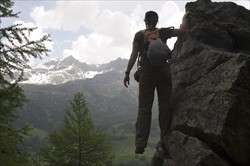Computer models predicts path of lost hikers

(PhysOrg.com) -- The next time a Boy Scout is lost in the wilderness, search and rescue teams could have better statistics on their side in deciding where to look.
The next time a Boy Scout is lost in the wilderness, search and rescue teams could have better statistics on their side in deciding where to look.
Lanny Lin, a Ph.D. candidate in Brigham Young University’s Computer Science Department, has developed computer models to predict where a lost hiker will go when he or she encounters tough terrain.
These techniques - which appear in the journal Computational and Mathematical Organization Theory - could help searchers better allocate their resources as they race against time and nature.
“As time progresses, the survivability of the missing person decreases and the effective search radius increases by approximately 3 kilometers per hour,” note Lin and BYU professor Michael Goodrich in their paper.
Lin’s statistical model calculates the most likely path a person would take when he or she comes across steep slopes, dense vegetation or water.
This predictive model starts with the point where a person was last seen and incorporates the amount of time he or she has been missing. The method combines this information with topographical data, vegetation, slope and terrain of the area and uses that to update the statistical estimates to help in the search.
In the study, Lin describes a plausible scenario where a Boy Scout becomes lost near Payson Lake. While searchers would have fanned out following the Scout’s original course of travel, the missing boy most likely would have looped back behind them when moving from a forest area to a nearby slope.
The statistical predictions are just one element of Lin and Goodrich’s search and rescue research. The magazine Popular Science featured an unmanned aerial vehicle that they’ve equipped with cameras to spot someone lost in the wilderness. This work is supported by the National Science Foundation.
Goodrich, a professor in the Computer Science Department, serves as Lin’s mentor in his doctoral work. Both are quick to give credit to all others involved in the project, emphasizing that they are just a small part of something that is hugely collaborative.
“We are building off a very long tradition,” said Goodrich. “Lanny has taken a big step forward in merging existing technologies into one method that will aid in rescuing those who get lost.”
More information: Research paper: www.springerlink.com/content/40013h2524576007/
Provided by Brigham Young University















